Grappenhall
OS Grid ref:- SJ6386
The attractive Cheshire village of Grappenhall, near Warrington contains some interesting buildings and retains its characterful cobbled roads and village stocks. The name derives from the Old English words 'grop', 'grep', or 'grepe' (meaning ditch/drain), and halh (meaning flat land by a river). The village was first mentioned in the Domesday book of 1086, referred to as 'Gropenhale' the land was described as having a wood with deer and was valued as being worth five shillings.
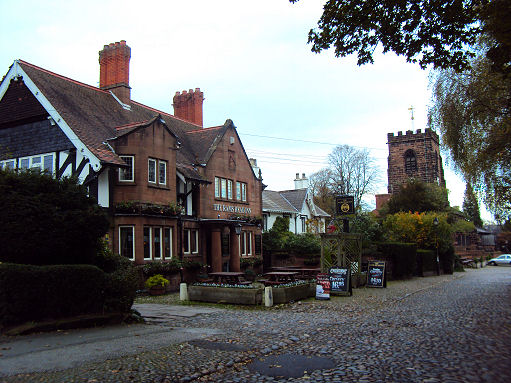
The village stands on the Bridgewater Canal, built for Francis Egerton, 3rd Duke of Bridgewater by James Brindley and completed in 1772, it was once a busy commercial enterprise transporting coal from the mines in Worsley near Manchester to industries in Widnes, Runcorn and Northwich where the fuel was used in the production of chemicals. Nowadays the quiet towpath of the canal makes for a pleasant stroll.

A Norman church stood on the site of the Church of St. Wilfred although it was largely rebuilt in the sixteenth century. The earliest recorded rector of the church was in 1189. A small chapel was added to the church by the local Boydell family in 1334 and contains a commemorative window in their honour. Fragments of medieval glass have been preserved from the chapel which form the most extensive medieval stained glass in Cheshire. During nineteenth century building work a Saxon font of the local red sandstone was discovered at a depth of about three feet below floor level. The chancel contains an effigy of Sir William Boydell, who died in 1275. The reredos is carved in oak and is based on the painting of The Last Supper by Leonardo da Vinci.
Village Stocks outside the church

The carving of a cat which adorns the west face of the church tower is said to have been the inspiration for the grinning Cheshire cat in Lewis Carrol's famous children's story 'Alice's Adventures in Wonderland'. Carrol was born in the nearby village of Daresbury. By the gate to the churchyard stand the two stone uprights of the village stocks contained within a railed enclosure.
The Bridgewater Canal at Grappenhall
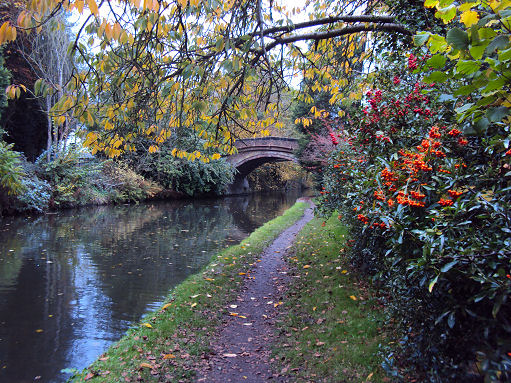
The Ram's Head Pub in the village main street serves meals and is a popular spot for visitors to relax in. The ram's head was the crest of the Leghs of Lyme. South of the church stands the nineteenth century rectory. Parts of the Case-Book of Sherlock Holmes were filmed in the cobbled centre of Grappenhall.
St. Wilfred's Church seen from the forecourt of the Rams Head pub
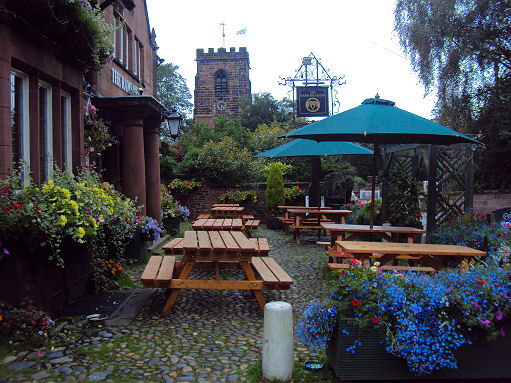
Grappenhall Heys Walled Garden was created in the early 19th century for the neighbouring house of Grappenhall Heys, to produce food and flowers for the house and as a pleasure ground. Over recent years the Garden has been extensively restored, and it is now starting the latest phase of its life under the ownership of Grappenhall and Thelwall Parish Council. The garden is situated on Witherwin Avenue, near the roundabout on Lumb Brook Road.
Bronze Age Barrow at Grappenhall
The first occupants of the Warrington area lived in Bronze Age communities at Grappenhall, Winwick and Croft in around 1000 BC. In the early 1930's an amateur archaeologist made an exciting discovery, when he found the remains of a Bronze Age barrow at Grappenhall.
Bronze Age Pottery and the Quern Stone recovered during the excavation at Grappenhall
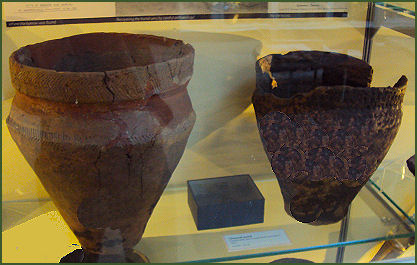
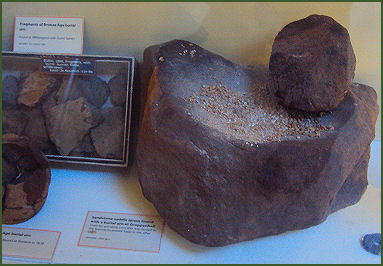
The barrow was situated just to the north of Stanney Lunt Bridge over the Bridgewater Canal. A local resident and a builder had noticed large sandstone blocks in a field and contacted Mr. Dunlop, then curator of Warrington Museum, who led an excavation of the site. Dunlop took photographs of the site and made careful drawings of the barrow. The excavation unearthed several pottery urns dating from the Bronze Age, containing the remains of burnt bones, several flint tools and a quern stone which would have been used to grind corn.
Nearby places of interest
Walton Hall Gardens, situated to the south west of Warrington, was originally part of a much larger country estate, purchased in 1812 by the famous Greenall brewing family.
